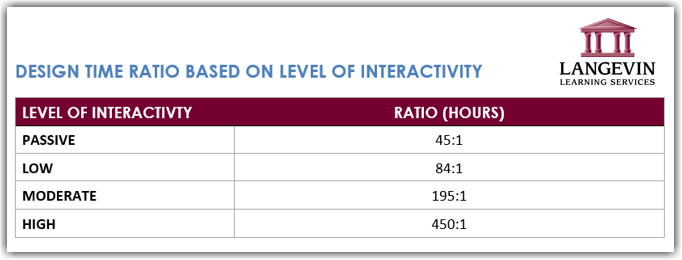Photo by: AndreyPopov via Canva
So, you’ve been asked to design a training program. One of the first questions you’ll ask is, “What’s the deadline for the course?” or “How much time do we have?” In a perfect world, we’d design our courses as we see fit, with no limitations. But how often does that happen? In the real world, we’re faced with constraints. One of the biggest constraints is time.
When we think about timing, it’s always best to use historical data. This is where we use our past experience and performance to estimate our design time. If we don’t have historical data to rely on, we use industry ratios. These are compiled from professional associations and industry experts.
At Langevin, we’ve compiled our own data, based on the latest industry stats and our 35+ years of experience designing training.
Let’s focus on e-learning and, specifically, how much time is needed to design a stand-alone asynchronous module. Well, the first question that needs to be addressed focuses on how involved the learners will be with the course. What level of interactivity is expected? This has a direct impact on our design time.
There are four levels of interactivity in asynchronous e-learning:
1. Passive – This type includes simple navigation such as clicking “next” to move to the next page
2. Low – This type includes minimal interactivity using basic navigation controls. Here, the learners interact with the content and can apply the content via simple practice exercises like sequencing, buttons, and hot spots.
3. Moderate – At this level, there is a greater degree of complexity and customization to the course content. It includes interactive learning activities like drag-and-drop interactions, simple games, scenario-based cases, and interactive videos and branching scenarios. Navigation will include menus, tabs, and progress bars.
4. High – This level of interactivity immerses learners into the content via complex simulations, game-based learning, virtual reality, or augmented reality. It typically includes in-depth branching scenarios, complex interactive videos, simulations, the use of avatars, a variety of multimedia, and customized navigation.
We’ve come a long way when it comes to e-learning. In the early days, most courses were passive or had low interactivity. Essentially, you clicked from one frame to the next and, if you were lucky, there was a multiple-choice test at the end. Now, organizations expect moderate to high levels of interactivity.
What most senior level stakeholders don’t realize is that the higher the level of interactivity, the longer it takes to design and develop. It’s our job to make them aware of this at the planning stage to set proper expectations with timing and due dates.
Below we have a table that shows the approximate design time ratios based on the level of interactivity. These ratios are in hours and represent the number of hours required to design and develop one hour of e-learning. This will help you determine the level of interactivity you can build into the course based on your time constraints.

How do you estimate design time? What ratios are you using?
For even more tips on how to design performance-based asynchronous e-learning, check out our Instructional Design for e-Learning workshop. You’ll gain the skills and knowledge to design an e-learning program that is instructionally sound, functional, and graphically effective.
